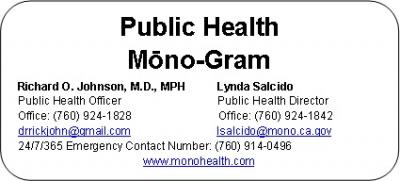Mono-Gram - Salmonella Outbreak
Wednesday, October 09, 2013
Outbreak of Infections Linked to Foster Farms Brand Chicken
The U.S. Department of Agriculture’s (USDA) Food Safety and Inspection Service (FSIS) has issued a public health alert due to concerns that illness caused by strains of a bacteria known as salmonella are associated with raw chicken products produced by Foster Farms at three facilities in California. The products were mainly distributed to retail outlets in California, Oregon, and Washington State. Raw products in question bear one of the establishment numbers inside a USDA mark of inspection or elsewhere on the package:
• P6137
• P6137A
• P7632
As of October 7th, a total of 278 persons infected with seven outbreak strains of Salmonella Heidelberg have been reported from 17 states. 42% of ill persons have been hospitalized, which is about twice the expected number with salmonella infections. The outbreak strains are resistant to several commonly prescribed antibiotics. This antibiotic resistance may be associated with an increased risk of hospitalization or possible treatment failure in infected individuals. No deaths have been reported thus far. 77% of ill persons have been reported from California, as shown on the following page.
The outbreak is continuing, and Foster Farms is collaborating with federal and state scientists in the investigation. USDA personnel have continued to work during the federal government shutdown, and 7-8 CDC employees have been called back in to help monitor the situation. Additional actions may be taken based on any new evidence that is discovered.
If you think you may have become ill:
Most persons infected with Salmonella bacteria develop diarrhea, fever, and abdominal cramps 12 to 72 hours after infection. The illness usually lasts 4 to 7 days, and most persons recover without treatment. However, in some persons, the diarrhea may be so severe that the patient needs to be hospitalized. Salmonella infection may spread from the intestines to the bloodstream and then to other body sites and can cause death unless the person is treated promptly with antibiotics. Children younger than 5 years, older adults, and people with weakened immune systems are more likely to have a severe illness from Salmonella infection. Contact your healthcare provider if you think you may have become ill from eating contaminated food.
Advice to consumers:
While it is not unusual for raw poultry from any producer to have Salmonella bacteria, it is uncommon to have multidrug-resistant Salmonella bacteria. Salmonella is known to contaminate poultry flocks in the USA. It is naturally occurring in poultry and can be fully eradicated if raw product is properly handled and fully cooked. Several European countries have succeeded in eradicating it in their flocks through stringent controls, but those controls are considered too costly to implement in the USA.
CDC and USDA-FSIS recommend consumers and retailers follow these food safety tips to prevent Salmonella infection from raw poultry produced by Foster Farms or any other brand:
- Clean
Wash hands with warm soapy water for 20 seconds before and after handling raw meat, poultry or seafood.
Wash utensils, cutting boards, dishes, and countertops with hot soapy water after preparing each food item and before you go on to prepare the next item.
Food contact surfaces may be sanitized with a freshly made solution of 1 tablespoon of unscented, liquid chlorine bleach in 1 gallon of water.
- Separate
Separate raw meat, poultry, and seafood from other foods in your grocery shopping cart and in your refrigerator.
If possible, use one cutting board for fresh produce and a separate one for raw meat, poultry, and seafood.
Never place cooked food on a plate that previously held raw meat, poultry, or seafood.
- Cook
Cook poultry to a safe minimum internal temperature of 165°F as measured with a food thermometer.
Retailers should hold cooked poultry to a safe minimum internal temperature of 165°F or higher as measured with a food thermometer.
• Chill
Chill food promptly and properly. Refrigerate or freeze perishables, prepared foods, and leftovers within 2 hours (or 1 hour if temperatures are above 90°F).
Note: While cooking instructions may give a specific number of minutes of cooking for each side of the product in order to attain 165 degrees F internal temperature, consumers should be aware that actual time may vary depending on the cooking method (broiling, frying, or grilling), the altitude, and the temperature of the product (chilled versus frozen). It is important that the final temperature of 165 degrees F be reached for safety. Please do not rely on the cooking time for each side of the product, but use a food thermometer, which is the only way to know that food has reached a high enough temperature to destroy foodborne bacteria.
Consumers with food safety questions can "Ask Karen," the FSIS virtual representative available 24 hours a day at AskKaren.gov. The toll-free USDA Meat and Poultry Hotline 1-888-MPHotline (1-888-674-6854) is available in English and Spanish and can be reached from l0 a.m. to 4 p.m. (Eastern Time) Monday through Friday. Recorded food safety messages are available 24 hours a day.
It is likely that more specific information on this fairly large outbreak will be delayed due to the current political stalemate in Washington, which has affected, and will continue to affect, surveillance of outbreaks of disease.



